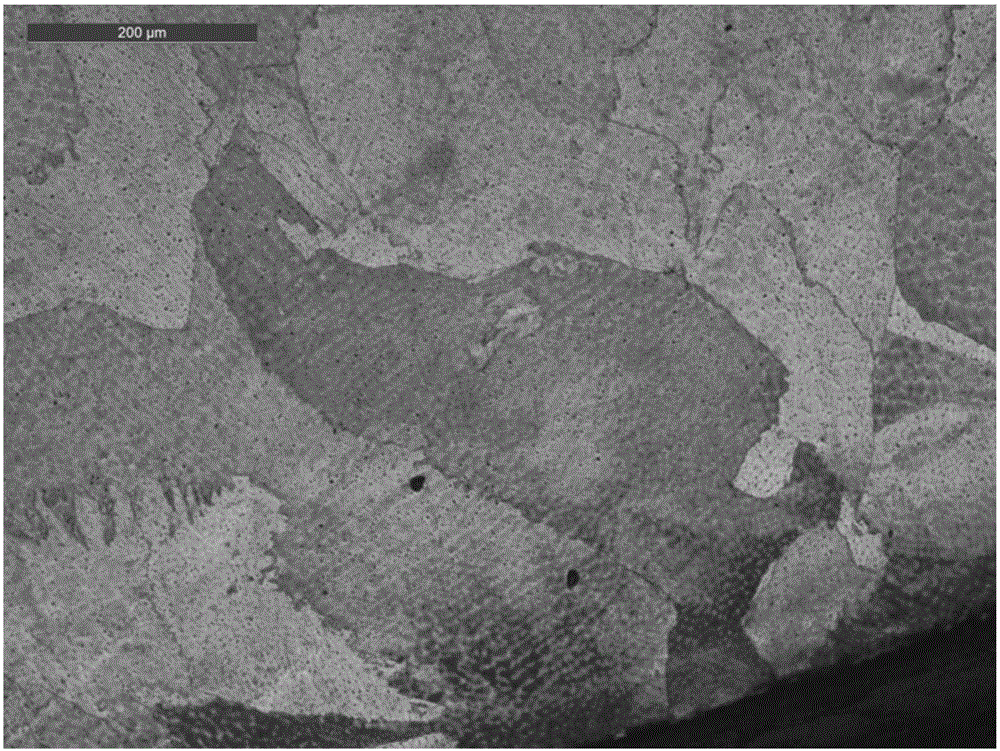Preparation method of lead-acid battery grid alloy containing lead tin-rare earth-graphene
A lead-acid battery and graphene technology, which is applied in lead-acid batteries, battery electrodes, circuits, etc., can solve the problem of not achieving uniform dispersion of graphene, and achieve the effects of reduced grain size, reduced corrosion, and simple preparation process
- Summary
- Abstract
- Description
- Claims
- Application Information
AI Technical Summary
Problems solved by technology
Method used
Image
Examples
Embodiment 1
[0052] 1. Preparation of lead-graphene composites
[0053] (1) Surfactant treatment is carried out to graphene powder
[0054] According to the ratio of 80g / L, the commercial graphene powder was added into the surfactant solution, soaked for 60min, and the soaking process was assisted by ultrasound. After soaking, the graphene powder was washed to neutral, filtered with suction, and then dried at 100°C. Sodium dodecylbenzenesulfonate was used as the surfactant, and the concentration of the surfactant was 2g / L.
[0055] (2) Configure the dispersion plating solution
[0056] The dispersion plating solution adopts lead citrate plating solution, and the specific formula is: citric acid 90g / L, potassium hydroxide 25g / L, ammonium acetate 85g / L, lead acetate 45g / L, brightener BD-1 is 80g / L.
[0057] (3) Add 5g / L graphene powder through surface active treatment in the dispersion electroplating solution, take titanium plate, platinum plate or other inert conductive matrix as anode, ...
Embodiment 2
[0088] 1. Preparation of lead-graphene composites
[0089] (1) Surfactant treatment is carried out to graphene powder. According to the ratio of 300g / L, the commercial graphene powder was added into the surfactant solution, soaked for 30min, and the soaking process was assisted by ultrasound. After soaking, the graphene powder was washed to neutral, filtered with suction, and then dried at 100°C. The surfactant is cetyltrimethylammonium bromide, and the concentration of the surfactant is 0.1 g / L.
[0090] (2) Configure the dispersion plating solution. The dispersion electroplating solution adopts lead methanesulfonate plating solution, and the specific formula is: 40 g / L of lead methanesulfonate, 125 g / L of methanesulfonic acid, 0.25 g / L of salicylaldehyde alkyl ether, and 0.1 g / L of bismuth nitrate.
[0091] (3) Add 15g / L graphene powder through surface active treatment in the dispersion electroplating solution, take titanium plate, platinum plate or other inert conductive...
Embodiment 3
[0106] 1. Preparation of lead-graphene composites
[0107] The preparation method is the same as in Example 2.
[0108] 2. Preparation of master alloy
[0109] The formula of the master alloy is as follows: 5.0% tin, 0.2% lanthanum, 0.5% cerium, and the balance of lead, and the above ratios are all percentages by weight.
[0110] The process steps for preparing the mother gold are the same as in Example 1.
[0111] 3. Preparation of lead battery grid
[0112] The formula of the grid alloy is as follows: 0.5% of tin, 0.02% of lanthanum, 0.05% of cerium, 4.0% of lead-graphene composite material, and the balance of lead, and the above ratios are all percentages by weight.
[0113] The process steps for preparing the grid alloy are the same as those in Example 1.
[0114] 4. Performance testing of lead battery grid
[0115] The detection method is the same as in Example 1.
[0116] The results are shown in Table 3.
[0117] table 3
[0118]
[0119] The alloy formula of...
PUM
 Login to View More
Login to View More Abstract
Description
Claims
Application Information
 Login to View More
Login to View More - R&D
- Intellectual Property
- Life Sciences
- Materials
- Tech Scout
- Unparalleled Data Quality
- Higher Quality Content
- 60% Fewer Hallucinations
Browse by: Latest US Patents, China's latest patents, Technical Efficacy Thesaurus, Application Domain, Technology Topic, Popular Technical Reports.
© 2025 PatSnap. All rights reserved.Legal|Privacy policy|Modern Slavery Act Transparency Statement|Sitemap|About US| Contact US: help@patsnap.com



